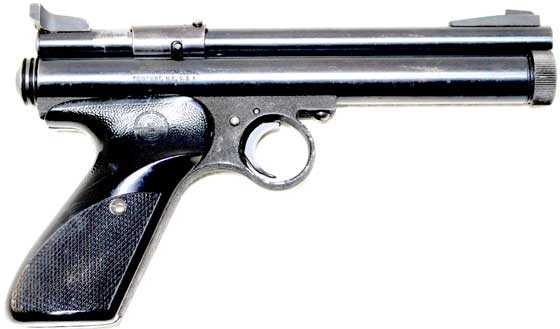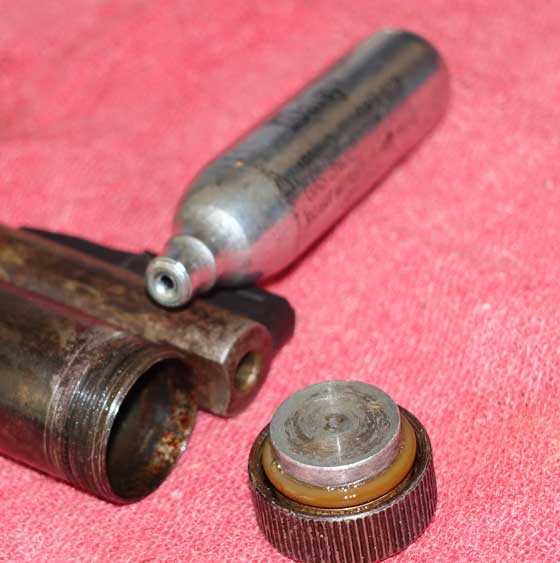Crosman 150: Part 2
by Tom Gaylord
Writing as B.B. Pelletier

Crosman’s 150 looks plain and simple, but was a pivotal airgun.
This report covers:
- Leave the pipe wrench alone!
- Different type of inlet valve
- Velocity test
- RWS Hobby
- RWS Superpoint
- Crosman Premier
- More on the pistol
- Test gun
Today we look at the velocity of my Crosman 150 pistol. When I started this test the gun had been holding gas for more than a year. I exhausted the CO2 cartridge that was in it and I need to say a word about that. The 150’s design is such that there is no easy way to exhaust the gas. I just shoot it out. The CO2 chamber is filled with pressurized gas that keeps the o-ring sealing the end cap tightly until the pressure drops. But we are lucky today, because when this gun was new that o-ring was made of a different material that absorbed gas and swelled up. It sometimes had to sit empty for a couple hours before you could get the cap off!
Leave the pipe wrench alone!
Do not try to remove the end cap if it feels tight! The reason it feels tight is there is about 850 psi of gas pressure forcing the o-ring against the reservoir body. If you remove the cap while there is pressure inside it will become a heavy missile that can kill! Shoot the gun until you hear that it’s empty and, if you have the right kind of o-ring, the cap should unscrew with finger pressure.
Different type of inlet valve
If you have never owned one of these vintage airguns, some explanation is in order. Their inlet valves do not work like the valves in today’s airguns. Instead of piercing as the end cap is screwed tioght, nothing happens until the gun is cocked and fired. The first shot will sound very weak because almost no gas escapes. It’s just been released from the CO2 cartridge by the moving piercing pin. Shot number 2, however, will be full power. And the gun is ready to shoot.

The white o-ring (turned brown from the Pellgunoil) doesn’t absorb CO2 gas, so the cap can be removed as soon as the gas is out. Notice the huge hole made by the piercing pin.
I installed a fresh cartridge, with Crosman Pellgunoil on its tip, of course. Then I took the piercing shot, followed by a confirmation shot that told me the gun was ready to go.
Velocity test
Because the 150 goes through gas pretty fast, I shot 5 shots on high power and 5 on low power with each pellet for the velocity test. I expected to get 35-40 shots from a cartridge. I did wait about 10 seconds between shots, but most of that was taken up loading the pistol and cocking it. More about that later.
RWS Hobby
Five RWS Hobby pellets averaged 427 f.p.s. on high power. The range went from 425 to 432 f.p.s. At the average velocity this pellet generates 4.82 foot-pounds of energy at the muzzle.
The discharge noise was very loud, which is characteristic of the 150. It also recoils just a little.
On low power Hobbys averaged 369 f.p.s., with a 5-shot spread that went from 364 to 375 f.p.s. At the average velocity Hobbys developed 3.60 foot-pounds at the muzzle.
The discharge noise is greatly reduced on low power. There is also no noticeable recoil. The trigger pull remains the same on low and high power.
RWS Superpoint
The next pellet I tested was the RWS Superpoint. On high power they averaged 410 f.p.s. which generated 5.41 foot-pounds of energy. The spread went from 408 to 412 f.p.s.
On low power Superpoints averaged 342 f.p.s. That’s good for 3.77 foot-pounds of energy. The range was from 332 to 346 f.p.s.
Crosman Premier
The final pellet tested was the Crosman Premier. On high power Premiers averaged 409 f.p.s., which is good for 5.31 foot-pounds of energy. The spread went from 404 to 414 f.p.s.
On low power Premiers averaged 345 f.p.s. That generates 3.78 foot-pounds of energy at the muzzle. The range went from 336 to 349 f.p.s.
How much power?
That concludes the velocity test. This 150 is on the low side of normal for a 150 in my experience. I’ve seen 150s that were tuned to push Hobbys over 500 f.p.s., but their gas economy was poor. Shooting this gun on low power is more pleasant than high power and still produces enough velocity for general use.
I found the test pistol to be very stable, where velocity is concerned. Of course there is a lot more steel in this gun than there is metal in a modern CO2 pistol, and all that mass acts as a heat sink. This is one pistol you just don’t have to worry about.
Shot count
As I noted, a 150 can be a gas hog. I estimated I would get 35-40 powerful shots per cartridge on high power. Of course I have been shooting on low power some of the time in this test, so we should see a few more shots than that.
After the velocity tests, when 31 shots had been fired (one failed to register through the chronograph) I started shooting RWS Hobbys on high power. Shot number 36 was a Hobby that went out at 414 f.p.s. That’s a little slower than the average, so the gun is starting to run out of gas. Shot 41 went out at 375 f.p.s., which is definitely off the power curve. Shot 45 was 330 f.p.s. and shot 50 was 256 f.p.s. All of this was on high power. By shot 45 I could hear the difference in the report and knew the end was approaching. I would have stopped there if I wasn’t testing the gun.
Trigger pull
As I noted earlier, the trigger pull seems consistent regardless of the power setting. It is a 2-stage pull with a very short stage 1. There is a small amount of creep in stage 2, but a pretty clean release at 2 lbs. 12 oz. This is a trigger I can work with.
Evaluation so far
I’m elated! I paid about $15-20 for this gun years ago at an airgun show because it was a leaker in rough shape. I “fixed” it with Automatic Transmission Sealant and now it’s back to normal. Everything is present and still works, even the cross-block safety. I could not be more pleased with the performance, thus far.

B.B. Thank you for this test! I’m elated! Also with my Crosman 157! You descript the trigger pull right on! Although I feel the second stage is getting smoother on my Crosman 157! Semper fi!
BB,
A nice little find there. This will likely be an excellent plinker.
BB,
For those of us who have not seen one of these things, in your next blog on this post a series of photos of the cocking/loading/firing sequence. Maybe even a video.
RR,
I’ll give that some thought!
B.B.
Great review!
I have a Hawthorne Montgomery ward M150 that is in excellent condition since only 2 co2 powerlets were ever used in it before it sat for 60 years, and today it shoots much harder than your chrony results .
They don’t make them like they used to.
B.B.,
You have inspired me to get my 157 out and shoot it a bit, although I am at a hectic time of the year at work (kind of like an accountant in the first half of April), so it will probably have to wait until the middle of May.
Your 150 seems like a pretty hot one. Your velocities with .22 are roughly what I always guessed my 157 achieved, but I confess I have never checked. When I dust off the 157, I should probably get my chronograph up and running, too. Chronying is how I discovered that my S&W 78G, which I bought from a fellow who said it had been “souped up” was producing about 7 foot pounds in the high power setting. The shot count was always so low that I have usually shot it on low power.
Man, those vintage CO2 pistols were/are great.
Michael
B.B.
What an intriguing piece of engineering; I look forward to the accuracy testing. =)
take care & God bless,
dave
I have a healthy respect for parts that are on too tight. When I got my Anschutz 1907, I had this scheme to change out the firing pin for one that could dry fire without impact, then replace the regular one for shooting. But the bolt would not disassemble according to instructions and the dealer had no advice. Darned if I was going to haul on that expensive machinery with pliers. So, I just dry fire cases or just work the trigger.
The day is coming when I will be able to resume shooting, and I cannot wait. It seems like it’s been forever.
Matt61
Hi Matt,
Another option for dry firing a .22 rifle is to use plastic drywall anchors. I use 6-7-8 X 7/8 inch yellow plastic anchors, and the “rim size” is perfect for .22 long rifle. The even cycle through the magazine and eject in my Savage bolt action .22! The “rim” holds up for quite a few firings before I throw them out, and they are inexpensive.
Mike